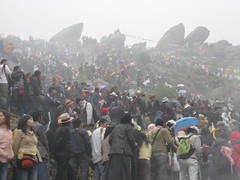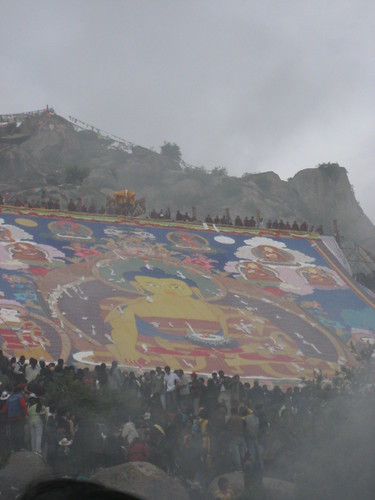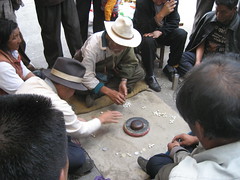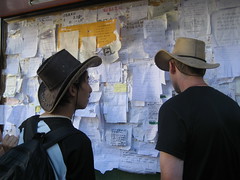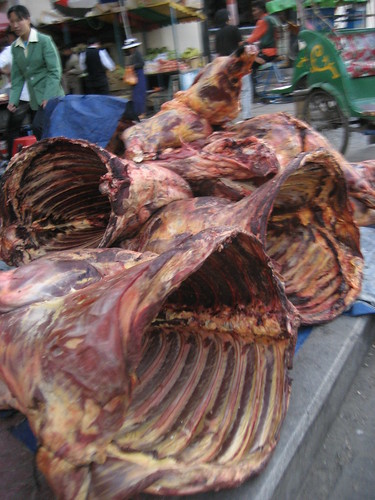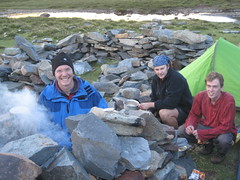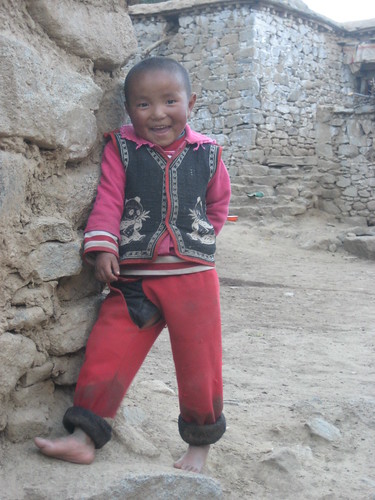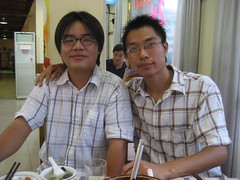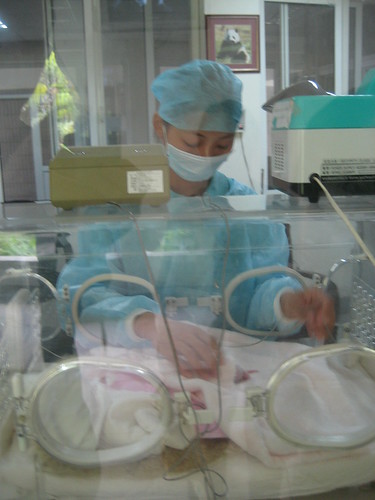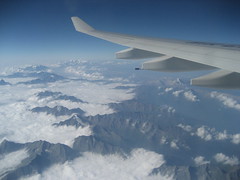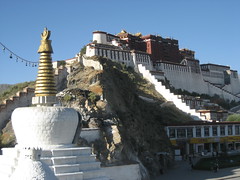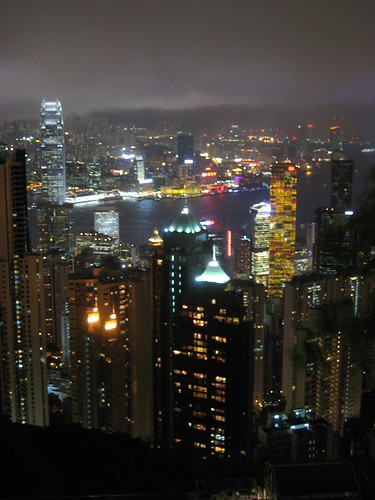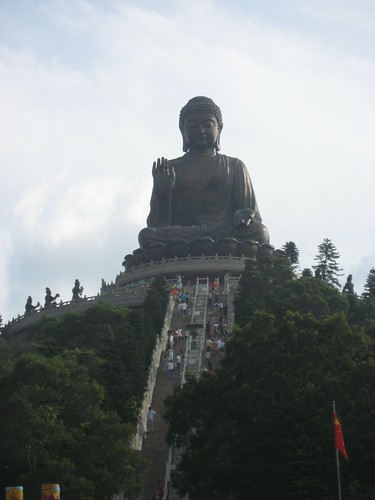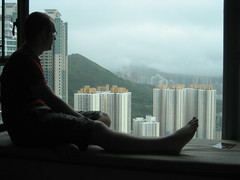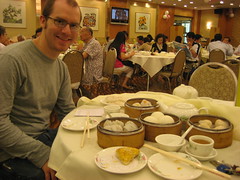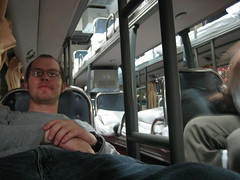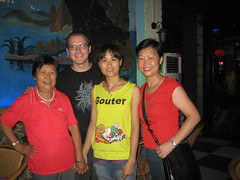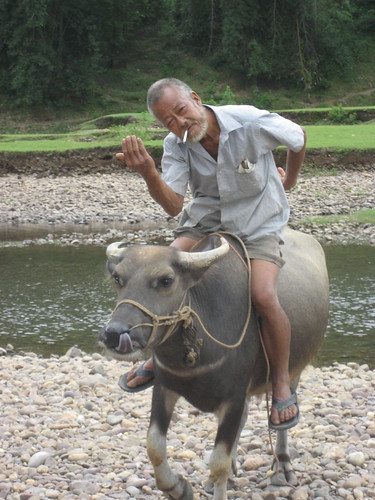In the Shadow of Everest
UPDATE: I just spent a looooong time uploading photos on a very slow internet connection, so there are now photos within the two latest journal entries plus a ton more on my Flickr account, including an excessive amount of Mt. Everest photos.
My four-day journey from Tibet to Nepal started by joining up with Rob, Lauren and Noah, three highly enjoyable Americans I met by posting notices on message boards around Lhasa. We tossed our stuff in our Land Cruiser and were off, speeding out of the city and curving up a mountain pass for a couple of hours in order to get great views of the shimmering turquoise Yamdrok-Tso Lake just before rain struck. Back down in the valley, we passed tiny rural villages on our way to our first stop Gyantse, a little city dominated by a large fortress perched up on a hill. We arrived in time to see the city's manageable monastery and grab some yak-n-noodle soup just before the sun set.
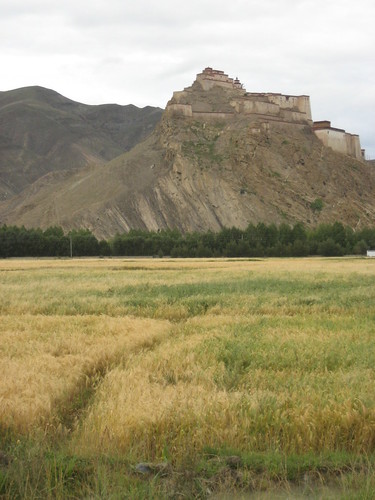
We drove through dark with our driver's Tibetan pop cassette tape blasting on repeat and finally arrived in Shigatse, the second largest city in Tibet next to Lhasa. The next morning we meandered through the city's great monastery which houses a huge golden buddha, got some yak burgers and tea near our hotel, then jumped back in the Land Cruiser for a long day of driving. We arrived at nightfall in Shegar, a one-street photographer's paradise that sits right outside the entry area to the Qomolangma Nature Preserve. Most people are more familiar with Qomolangma's English name: Mt. Everest.
We woke up before dawn the next morning and sleepily piled in the car once again, passed through several permit checks as the sun came up. The car drove through switchback after switchback and when we reached the top of the pass we were awed as we caught our first glimpse of Mt. Everest far across the wide valley. Three more hours of driving brought us to Rhongpu Monastery, famous for its dramatic views of Everest. As we arrived, the views were completely covered by a solid wall of clouds.
Noah, Rob and I decided to make the two-hour walk from the monastery to Everest Base Camp, which has been the preliminary home to Everest expeditions since before Sir Edmund Hillary first conquered the 29,028 foot mountain in 1953. As we started walking, the clouds began to miraculously part and Mt. Everest began to reveal itself to us in pieces. Within a half-hour, we were walking along a path toward a completely visible Mount Everest. Seeing the highest mountain in the world with my own eyes is the highlight of my trip so far, and is something that I won't forget for as long as I live.
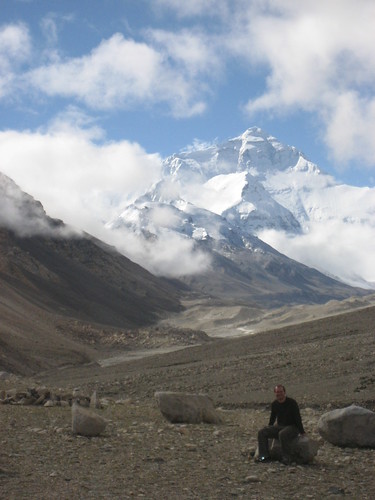
Base Camp itself is a huge series of large canvas tents that serve as guesthouses and restaurants for visitors to the camp. We saw only one set of expedition tents — most of the summit attempts are made in May. Since we had extremely good luck by getting great views (the previous day the mountain was covered from sunrise to sunset), we decided to get moving by mid-afternoon toward Tingri, a town a few hours from the Nepal border. We noticed that the road from Everest Base Camp to Tingri is only shown on about half the maps we've seen, and once we saw it in person we found out why. The road is a series of occasional tire prints winding through a rocky and muddy valley that under very few circumstances would ever be considered a road — a vague path is a more accurate term. Our driver made every 4-wheel-drive enthusiast in the United States look like a bunch of stupid pansies; I've never seen someone do crazier crap while driving a car. Here's a shot out the window — we're on the road, even though it looks strikingly like a river.
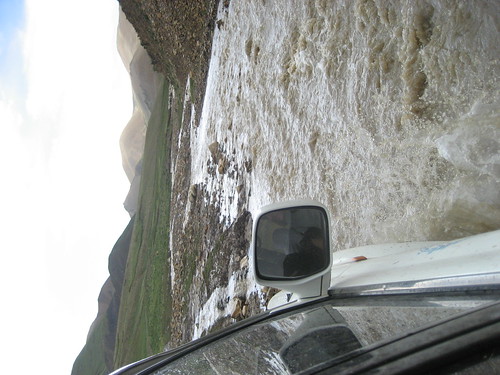
We got to Old Tingri after four hours of crazy four-wheeling, bargained hard for a hotel room and wandered around the town. Exploring the city is like walking around in an old west movie — horses are tied up outside the saloon, little country stores and restaurants line the main street, and animals of all varieties casually wander looking for their next meal. We hit the rack late, our bellies full of the light but decent Lhasa Beer and more yak meat, just about the only food available in Tibet.
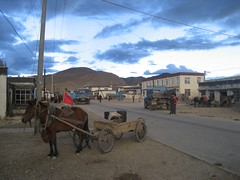
We rose early in Tingri and got out of town quickly in an attempt to get to Nepal as early as possible. Another long day of driving brought us atop a pass with an elevation over 17,000 feet before plummeting down toward the border through the most spectacular valley I’ve ever seen. Waterfalls poured down from all directions, sometimes directly onto the road, making for an incredibly fun and beautiful ride through misty forests. In the early afternoon, we parted ways with our driver (along with his terrible taste in music) in the border town on the Chinese side where we had to walk a few miles to the actual border. A fairly painless exit from China brought us to a six mile no-mans land of harrowing switchbacks that led directly below to the bottom of the valley where we paid our $30 and breezed through the seemingly voluntary Nepal visa process.
The six of us, including Yael and Alon two Israelis we met along the way, haggled for a shared jeep from the Nepali border town to Kathmandu. We bargained well, and the five-hour drive cost us right around four dollars each inside a gigantic military-style jeep. We were all surprised at the drastic differences between Tibet and Nepal — we passed through fifty or so Nepalese towns on our way into the big city which were much more Indian influenced than I had expected. Women wear bright saris, buildings have intricate carved detail, and the majority of signs are lovingly and expertly hand-painted. Within a few hours, we had dropped into the Kathmandu valley, an unbelievable 13,000 feet lower than the elevation a few hours before in Tibet. I certainly never imagined I'd see the Himalayas and palm trees in the same day.
We made it into the outskirts of Kathmandu where our college-aged driver brilliantly dodged the absolutely insane traffic, chasing behind a speeding ambulance for much of the way. I found a copy of the Kathmandu Driving Handbook, which I have carefully transcribed for you in its entirety:
-
City of Kathmandu
Driving Rules & Regulations
Article 1, Section 1:
Go nuts!
-
Despite almost getting killed in the traffic about thirty times, I'm thrilled to be in Kathmandu so far. First off, it is cheap as the dickens compared to China — a clean double room with a private bathroom, hot shower and TV runs about $3.50 per night, about a quarter of what it would cost in Tibet. The city has a remarkably fast pulse, but is extremely relaxing at the same time. Goats, water buffalo, and chickens wander the streets while motorcycles and rickshaws buzz past.
Touts in the Thamel, the main tourist area, desperately try to sell trekking trips, hotel rooms, crappy knick-knacks and hash. Bars and restaurants have a distinct hippie vibe, and although that’s not really my cup of tea it's been fun to just hang out with friends and relax over tea and deliciously spicy Nepali food for the last couple of days.
I'm planning to hang out in the city for a few days longer, do a bit of trekking in the Himalayas, then head south into northern India in a few weeks which I picture as a really intense version of Nepal. Thanks for reading as always.
Ryan!
